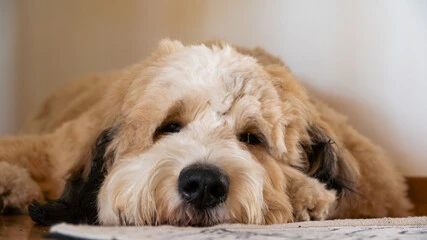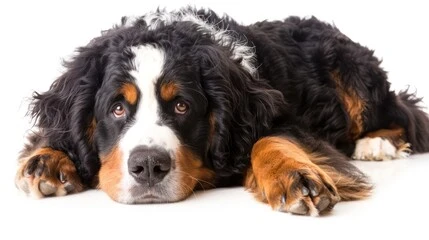Do Mini Bernedoodles Shed?

We often think about whether “Mini Bernedoodles shed or not”, so here we are answering all your queries about the shedding of mini bernedoodle. Several attractive characteristics make Mini Bernedoodles excellent household pets or canine companions. However, there is a misconception regarding Poodle hybrid breeds that all Doodles would be hypoallergenic and completely shed-free.

If you’re curious about the size and appearance of a full-grown Mini Bernedoodle, they typically range from 18 to 22 inches in height and weigh between 25 to 50 pounds.
Even while Doodles don’t shed much, you can’t be sure your hybrid dog won’t occasionally splatter hair on your furniture or clothing.
Shedding in Bernedoodles? Comparing Breed Generation
You’ve decided that you want a low-shedding Bernedoodle, but now you have to decide which generation to choose. Which Bernedoodle coat is ideal for those who have allergies? Do Bernedoodle Minis shed? Which Bernedoodle dries out the most?
Selecting the correct Bernedoodle generation can be difficult because doodle breeders specialize in different generations. What do the various generations signify, and how may they impact the amount of hair a Bernedoodle sheds? Here’s a brief synopsis:
| Generations | First parent | Second parent | % of First parent | % of Second Parent |
| F1 Bernedoodle | Bernese Mountain Dog | Poodle | 50% | 50% |
| F1B Bernedoodle | F1 Bernedoodle | Poodle | 25% | 75% |
| F1BB Bernedoodle | F1B Bernedoodle | Poodle | 12.5% | 87.5% |
| F2 Bernedoodle | F1 Bernedoodle | F1 Bernedoodle | 50% | 50% |
| F2B Bernedoodle | F1 Bernedoodle | F1B Bernedoodle | 37.5% | 62.5% |
| F2B Bernedoodle (alternate cross) | F2 Bernedoodle | Poodle | 25% | 75% |
| F3 / Multigen Bernedoodle | F1B Bernedoodle or higher | F1B Bernedoodle or higher | Varies | Varies |
Do F1 Bernedoodles Shed or not?
50% Poodle and 50% Bernese Mountain Dog make up the F1 Bernedoodle. Because of this, F1 Mini Bernedoodles shed more likely than backcross generations.
On the other hand, it’s also not unusual for F1 Bernedoodles to inherit a coat that is more poodle-like. Puppies belonging to the same F1 breed may have distinct coat styles! The puppy’s coat type that it received from its parents ultimately determines everything.
On the other hand, it’s also not unusual for F1 Bernedoodles to inherit a coat that is more poodle-like. Puppies belonging to the same F1 breed may have distinct coat styles! The puppy’s coat type that it received from its parents ultimately determines everything.
Do F2 Bernedoodles Shed or not?
F2 Bernedoodles are a 50/50 blend of the Bernese Mountain Dog and Poodle, much like F1 Bernedoodles. They, therefore, have a 50% chance of inheriting the low-shedding curly coat or the shedding straight coat. Of course, wavy coats are also possible in F2 Bernedoodles; these coats shed a little bit more than curly coats but less than straight coats.
Do F1b Bernedoodles Shed or not?
Compared to their F1 cousins, F1b Bernedoodles are far more likely to be low-shedding canines. Given that F1b Bernedoodles are genetically 75% Poodle and 25% Bernese Mountain Dog, it is more likely that the low-shedding genes come from the Poodle branch of the family.
Even F1b Bernedoodles, nevertheless, are occasionally able to possess the shedding gene. It is less likely, but it is not impossible. For those looking for a Doodle that doesn’t shed a lot, F1b Bernedoodles are said to be the greatest option. Mini bernedoodle shed seldomely, so there’s less chance of allergic responses occurring. Additionally, you won’t have to spend time vacuuming your carpets or furnishings after shedding hair.
Do F2b Bernedoodles Shed or not?
F2b Bernedoodles and F1b Doodles share a lot of genetic similarities. They are another excellent choice for those looking for a puppy that doesn’t shed a lot because they are 25% Bernese Mountain Dog and 75% Poodle.
Do F1bb Bernedoodles Shed or not?
The Bernedoodle, as mentioned earlier generations, has taught us that F1bb Bernedoodles have an even greater genetic proportion than Poodle. F1bb Bernedoodles have 12.5% Bernese Mountain Dog and 87.5% Poodle in them. This increases the likelihood that these puppies will be extremely low-shedding canines.
Do F2bb Bernedoodles Shed or not?
F2bb Bernedoodles are genetically 87.5% Poodle and 12.5% Bernese Mountain Dog, much like F1bb puppies. Once more, F2bb Bernedoodles are probably among the safest breeds for individuals with dog dander allergies because they do not shed.
Do Mini Bernedoodles Shed or not?
The breeding of a small Bernedoodle determines whether or not they sheds. Mini Bernedoodles, for example, can be produced as F1 Mini Bernedoodles or by backcross generation breeding, such as F1b and F2b Mini Bernedoodles.
Because F1 Mini Bernedoodles are genetically 50% Poodle and 50% Bernese Mountain Dog, we may often expect some of them to shed. This indicates that an F1 Mini Bernedoodle has a 50/50 probability of acquiring characteristics from one or both of the parent puppies.
But there’s a much less possibility of shedding with backcross generations like F1b, F1bb, F2b, and F2bb Mini Bernedoodles. All backcross generations have at least 75% Poodle DNA, as we have discovered from the generations above. They are, therefore, more likely to inherit a coat with little shedding.
Additionally, the Mini Bernedoodle coat type & color can influence shedding.
Conclusion
In conclusion, while Mini Bernedoodles shed are often considered low-shedding and hypoallergenic due to their Poodle heritage, it’s important to remember that no dog is completely shed-free. The amount of shedding can vary significantly depending on the generation and specific genetic makeup of the dog.
For those seeking a low-shedding companion, F1b and F2b Bernedoodles are generally the best options, as they have a higher percentage of Poodle genes, which are associated with less shedding. However, even these dogs may shed occasionally. Understanding the different generations and their characteristics can help you make an informed decision when choosing a Mini Bernedoodle that fits your lifestyle and allergy needs.
Ultimately, while Mini Bernedoodles can be a great choice for those looking for a low-shedding pet, it’s essential to have realistic expectations and be prepared for some level of shedding. Regular grooming and proper care can help manage shedding and keep your home clean and allergen-free.
FAQ’s
Do Mini Bernedoodles Shed? Understanding Their Coat and Care Needs
Mini Bernedoodles are a popular choice for dog lovers seeking a small, affectionate companion. They are generally low-shedding dogs, making them a suitable option for people with allergies. Understanding their shedding patterns can help potential owners know what to expect and how to care for their furry friends.

The amount a Mini Bernedoodle sheds can vary based on its genetics. Breeds such as the Bernese Mountain Dog and Poodle influence their coat types, which play a role in shedding. Regular grooming and maintenance can further reduce shedding and keep their coats healthy and shiny.
Key Takeaways
- Mini Bernedoodles are usually low-shedding, ideal for allergy sufferers.
- Genetic factors influence the shedding amount and coat types.
- Grooming plays an essential role in managing their shedding and coat health.
Understanding Mini Bernedoodles

Mini Bernedoodles are a unique mix of two beloved breeds: the Bernese Mountain Dog and the Miniature Poodle. Knowing their origins and physical traits helps potential owners understand what to expect in terms of temperament and care.
Breed Origins
Mini Bernedoodles are a designer breed that combines the best traits of their parent dogs. They were created to blend the friendly, gentle nature of the Bernese Mountain Dog with the intelligence and low-shedding coat of the Miniature Poodle. This crossbreed aims to provide a loving companion while reducing shedding and allergies often associated with shedding breeds.
The Mini Bernedoodle typically features a genetic background that varies depending on the specific breeding. An F1 Mini Bernedoodle would have equal parts of each breed, while F1b or F2 generations might have more Poodle, which affects traits such as coat type and shedding. This ancestry can influence their behavior and care requirements.
Physical Characteristics
Mini Bernedoodles come in various sizes and coat types. On average, they weigh between 10 to 50 pounds and stand about 12 to 22 inches tall. Their size may depend on the size of the Poodle parent.
Coats can be straight, wavy, or curly, often resembling the Poodle’s texture. This variety leads to differences in grooming needs. For example:
- Curly coats: Require regular grooming to avoid matting.
- Wavy coats: May shed less and need less maintenance.
- Straight coats: Often require more frequent brushing.
Mini Bernedoodles typically have the beautiful markings of the Bernese Mountain Dog, with colors ranging from black, brown, and white to cream. Their striking appearance makes them a popular choice for families and individuals alike.
Coat Types and Genetics

Mini Bernedoodles can inherit different coat types based on their parent breeds. Understanding these genetics is essential for predicting shedding and grooming needs.
Inheriting the Poodle’s Coat
When a Mini Bernedoodle takes after the Poodle parent, the coat tends to be curly or wavy. This type is known for being more hypoallergenic, which is a key trait for allergy sufferers.
The genetics of the Poodle contribute to a lower shedding rate. Poodles have dense, tightly curled fur that traps loose hair. Therefore, many Mini Bernedoodles that inherit this coat require regular grooming to maintain its health.
This curly coat needs consistent brushing to prevent matting. Owners should consider scheduling regular visits to a groomer to keep the coat in optimal condition.
Inheriting the Bernese Mountain Dog’s Coat
If a Mini Bernedoodle resembles the Bernese Mountain Dog, the coat will typically be straighter and longer. This coat type is more prone to shedding compared to the curly Poodle coat.
The Bernese Mountain Dog’s fur is thick and may require more frequent grooming. Regular brushing can help manage shedding and keep the coat healthy. Owners should be prepared for more fur around the house.
This coat variant might also lead to seasonal shedding, especially during warmer months. Understanding this trait helps owners manage expectations about maintenance and cleanliness.
Shedding Patterns and Triggers

Mini Bernedoodles experience shedding that can vary in intensity based on several factors. Age and seasonal changes are significant triggers that influence their coat.
Age-Related Shedding
Mini Bernedoodles go through different shedding phases throughout their lives. Puppies may shed their soft, puppy coat as they grow, usually between four to six months of age. This process may cause noticeable hair loss as adult fur begins to replace the puppy coat.
As they age, their shedding patterns can stabilize, generally reducing the amount of hair lost. Regular grooming during these phases is helpful. It not only manages loose hair but also keeps the coat healthy. Older Bernedoodles might shed more frequently due to changing hormones or health issues. It’s essential to keep an eye on their coat condition as they transition through these stages.
Seasonal Changes
Seasonal changes greatly impact a Mini Bernedoodle’s shedding. Most dogs, including Bernedoodles, tend to shed more during spring and fall. During these times, they lose their winter or summer fur.
In spring, they may shed heavier as they prepare for warmer weather. In contrast, during fall, they may shed to make room for a thicker winter coat. Owners should increase grooming during these seasons to manage the increased hair loss. Brushing several times a week helps control shedding and maintains coat quality, making it a crucial routine for pet care.
Grooming and Maintenance

Maintaining a Mini Bernedoodle’s coat requires regular attention and care. Effective grooming helps reduce shedding and keeps their coat healthy. Here’s what you need to know about regular brushing and professional grooming.
Regular Brushing
Regular brushing is essential for Mini Bernedoodles. Brushing helps to remove loose hair, dirt, and debris from the coat. This practice also prevents matting, which can be uncomfortable for the dog.
- Frequency: It is recommended to brush at least 2-3 times a week. During shedding seasons, daily brushing can be beneficial.
- Tools: Use a slicker brush or a comb designed for curly hair to effectively untangle and smooth the coat.
- Technique: Start from the roots and work your way to the tips. Be gentle around sensitive areas like the ears and belly.
Regular brushing not only keeps the coat in top shape but also strengthens the bond between the owner and the pet.
Professional Grooming
Professional grooming is another key element in maintaining a Mini Bernedoodle’s appearance. It is advisable to schedule grooming sessions every 6-8 weeks.
- What to Expect: A professional groomer will wash, dry, and cut the coat. They can also check for any skin issues or parasites.
- Benefits: Groomers have the experience and tools to handle tricky areas like the paws and face, ensuring a neat and clean look.
- Hygiene: Regular grooming appointments can help maintain hygiene by preventing ear infections and keeping nails trimmed.
Investing in professional grooming contributes to the overall health and well-being of a Mini Bernedoodle.
Health Considerations

Mini Bernedoodles can have some health issues that owners should be aware of. These issues may vary based on genetics, breed, and environmental factors. Paying attention to the dog’s health is essential for their well-being.
Allergies and Sensitivities
Mini Bernedoodles can be prone to allergies and sensitivities. Common allergens include pollen, dust mites, food ingredients, and grooming products. Owners should monitor their dog for signs like itching, redness, or digestive upset.
It’s helpful to keep a diary of any reactions to identify triggers. Switching to hypoallergenic products may also reduce sensitivity. If a dog shows persistent symptoms, a veterinarian should evaluate them for appropriate allergy testing and treatment options.
Regular grooming can help minimize allergic reactions by removing allergens from the coat. Keeping the living area clean can also aid in reducing exposure to irritants.
Frequently Asked Questions

Mini Bernedoodles can have various shedding patterns. The amount of shedding can depend on several specific factors, including genetics, grooming routines, and the individual dog’s health. Below are common questions that many potential owners have regarding shedding in Mini Bernedoodles.
How long can one expect shedding to continue in Bernedoodles?
Shedding in Bernedoodles can occur year-round, but it may increase during seasonal changes. Typically, owners may notice more shedding in spring and fall as dogs transition between winter and summer coats.
What factors contribute to variations in shedding among F1b Bernedoodles?
Variations in shedding can result from genetic background, particularly the balance of traits inherited from the Poodle and Bernese Mountain Dog. F1b Bernedoodles, which are a cross between an F1 Bernedoodle and a Poodle, might have more Poodle-like coats that can shed less.
In comparison to Goldendoodles, do Bernedoodles exhibit higher shedding levels?
In general, Bernedoodles may shed more than Goldendoodles. This is largely due to their Bernese Mountain Dog genetics, which can lead to greater shedding compared to the more hypoallergenic Poodle lineage commonly found in Goldendoodles.
At what stage do Bernedoodle puppies lose their puppy coat?
Bernedoodle puppies usually start to lose their puppy coat around six months of age. This process can vary, and some may retain their softer puppy fur longer before developing their adult coats.
What potential challenges are associated with raising a mini Bernedoodle?
Raising a Mini Bernedoodle can come with challenges such as grooming needs and monitoring for health issues. Their coats require regular brushing to prevent mats and tangles, which can become a time-consuming task.
Regarding hypoallergenic properties, how do mini Bernedoodles typically fare?
Mini Bernedoodles are often considered hypoallergenic due to their Poodle parentage. However, it’s important to note that not all Mini Bernedoodles will be completely non-shedding, as individual coat types can vary.
